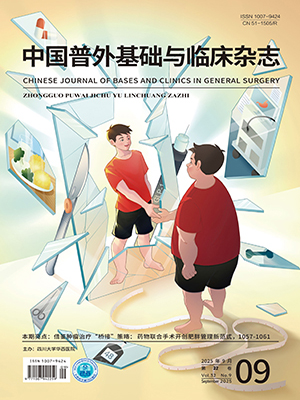| 1. |
Cao W, Chen HD, Yu YW, et al. Changing profiles of cancer burden worldwide and in China: a secondary analysis of the global cancer statistics 2020. Chin Med J (Engl), 2021, 134(7): 783-791.
|
| 2. |
Sung H, Ferlay J, Siegel RL, et al. Global cancer statistics 2020: GLOBOCAN estimates of incidence and mortality worldwide for 36 cancers in 185 countries. CA Cancer J Clin, 2021, 71(3): 209-249.
|
| 3. |
Vogel A, Meyer T, Sapisochin G, et al. Hepatocellular carcinoma. Lancet, 2022, 400(10360): 1345-1362.
|
| 4. |
Chen ZH, Zhang XP, Wang H, et al. Effect of microvascular invasion on the postoperative long-term prognosis of solitary small HCC: a systematic review and meta-analysis. HPB (Oxford), 2019, 21(8): 935-944.
|
| 5. |
Wu F, Sun H, Zhou C, et al. Prognostic factors for long-term outcome in bifocal hepatocellular carcinoma after resection. Eur Radiol, 2023, 33(5): 3604-3616.
|
| 6. |
Han J, Li ZL, Xing H, et al. The impact of resection margin and microvascular invasion on long-term prognosis after curative resection of hepatocellular carcinoma: a multi-institutional study. HPB (Oxford), 2019, 21(8): 962-971.
|
| 7. |
Yang P, Si A, Yang J, et al. A wide-margin liver resection improves long-term outcomes for patients with HBV-related hepatocellular carcinoma with microvascular invasion. Surgery, 2019, 165(4): 721-730.
|
| 8. |
Zhou JM, Zhou CY, Chen XP, et al. Anatomic resection improved the long-term outcome of hepatocellular carcinoma patients with microvascular invasion: A prospective cohort study. World J Gastrointest Oncol, 2021, 13(12): 2190-2202.
|
| 9. |
European Association for the Study of the Liver. EASL Clinical Practice Guidelines: Management of hepatocellular carcinoma. J Hepatol, 2018, 69(1): 182-236.
|
| 10. |
Lee S, Kang TW, Song KD, et al. Effect of microvascular invasion risk on early recurrence of hepatocellular carcinoma after surgery and radiofrequency ablation. Ann Surg, 2021, 273(3): 564-571.
|
| 11. |
Mazzaferro V, Llovet JM, Miceli R, et al. Predicting survival after liver transplantation in patients with hepatocellular carcinoma beyond the Milan criteria: a retrospective, exploratory analysis. Lancet Oncol, 2009, 10(1): 35-43.
|
| 12. |
Iguchi T, Shirabe K, Aishima S, et al. New pathologic stratification of microvascular invasion in hepatocellular carcinoma: Predicting prognosis after living-donor liver transplantation. Transplantation, 2015, 99(6): 1236-1242.
|
| 13. |
Bian X, Liu R, Meng Y, et al. Lipid metabolism and cancer. J Exp Med, 2021, 218(1): e20201606.
|
| 14. |
Broadfield LA, Duarte JAG, Schmieder R, et al. Fat induces glucose metabolism in nontransformed liver cells and promotes liver tumorigenesis. Cancer Res, 2021, 81(8): 1988-2001.
|
| 15. |
Guo Z, Liang J. Lipid-Based Factors: A promising new biomarker for predicting prognosis and conditional survival probability in hepatocellular carcinoma. J Hepatocell Carcinoma, 2022, 9: 869-883.
|
| 16. |
Liang JQ, Teoh N, Xu L, et al. Dietary cholesterol promotes steatohepatitis related hepatocellular carcinoma through dysregulated metabolism and calcium signaling. Nat Commun, 2018, 9(1): 4490.
|
| 17. |
中華人民共和國國家衛生健康委員會. 原發性肝癌診療指南(2022年版). 腫瘤綜合治療電子雜志, 2022, 8(2): 16-53.
|
| 18. |
中國抗癌協會肝癌專業委員會, 中華醫學會肝病學分會肝癌學組, 中國抗癌協會病理專業委員會, 等. 原發性肝癌規范化病理診斷指南(2015年版). 臨床肝膽病雜志, 2015, 31(6): 833-839.
|
| 19. |
Tian Y, Hua H, Peng Q, et al. Preoperative evaluation of Gd-EOB-DTPA-enhanced MRI radiomics-based nomogram in small solitary hepatocellular carcinoma (≤3 cm) with microvascular invasion: A two-center study. J Magn Reson Imaging, 2022, 56(5): 1459-1472.
|
| 20. |
Lei Z, Li J, Wu D, et al. Nomogram for preoperative estimation of microvascular invasion risk in hepatitis B virus-related hepatocellular carcinoma within the milan criteria. JAMA Surg, 2016, 151(4): 356-363.
|
| 21. |
Yan Y, Zhou Q, Zhang M, et al. Integrated nomograms for preoperative prediction of microvascular invasion and lymph node metastasis risk in hepatocellular carcinoma patients. Ann Surg Oncol, 2020, 27(5): 1361-1371.
|
| 22. |
Kimura Y, Sumiyoshi M. High-fat, high-sucrose, and high-cholesterol diets accelerate tumor growth and metastasis in tumor-bearing mice. Nutr Cancer, 2007, 59(2): 207-216.
|
| 23. |
Yang SY, Wang CC, Chen KD, et al. Statin use is associated with a lower risk of recurrence after curative resection in BCLC stage 0-A hepatocellular carcinoma. BMC Cancer, 2021, 21(1): 70.
|
| 24. |
Mathur A, Franco ES, Leone JP, et al. Obesity portends increased morbidity and earlier recurrence following liver transplantation for hepatocellular carcinoma. HPB (Oxford), 2013, 15(7): 504-510.
|
| 25. |
Huang Y, Huang X, Zeng J, et al. Knockdown of MUC16 (CA125) enhances the migration and invasion of hepatocellular carcinoma cells. Front Oncol, 2021, 1: 667669.
|
| 26. |
Baert T, Van Camp J, Vanbrabant L, et al. Influence of CA125, platelet count and neutrophil to lymphocyte ratio on the immune system of ovarian cancer patients. Gynecol Oncol, 2018, 150(1): 31-37.
|
| 27. |
Pérez-Tomás R, Pérez-Guillén I. Lactate in the tumor microenvironment: An essential molecule in cancer progression and treatment. Cancers (Basel), 2020, 12(11): 3244.
|
| 28. |
Ba??rsak?? E, ?ahin E, Atabey N, et al. Role of albumin in growth inhibition in hepatocellular carcinoma. Oncology, 2017, 93(2): 136-142.
|
| 29. |
Fujiwara R, Haag M, Schaeffeler E, et al. Systemic regulation of bilirubin homeostasis: Potential benefits of hyperbilirubinemia. Hepatology, 2018, 67(4): 1609-1619.
|
| 30. |
Yao Q, Jiang X, Zhai YY, et al. Protective effects and mechanisms of bilirubin nanomedicine against acute pancreatitis. J Control Release, 2020, 322: 312-325.
|




